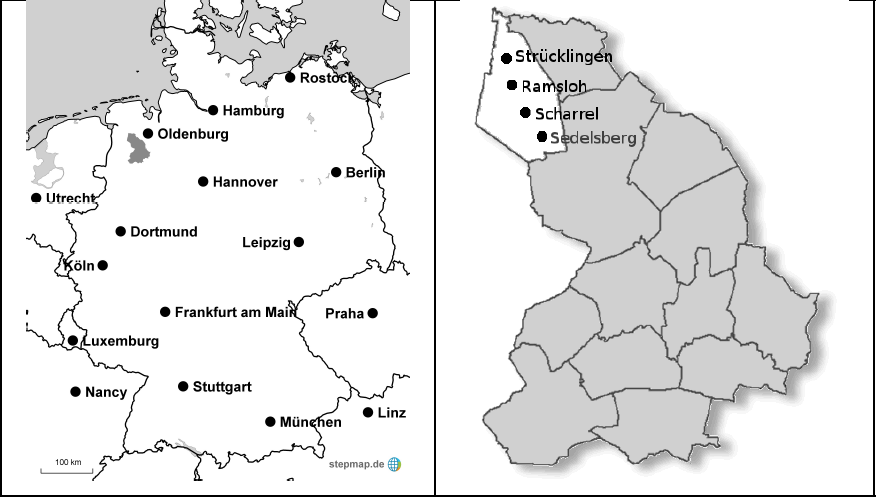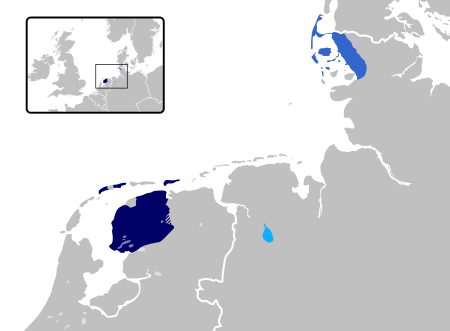This is an old revision of the document!
Table of Contents
Sater Frisian in Germany
Language designations:
Language vitality according to:
Linguistic aspects:
- Script: Latin
Language standardization
The American linguist Marron Fort collected words while doing linguistic research over a span of 20 years in Saterland.3) With this collection, he created the Sater Frisian Dictionary and by that a coherent orthography. With help of this dictionary, he translated the New Testament into Sater Frisian. 4) West-Frisian Pyt Kramer has also contributed to the standardization of Sater Frisian, with the Seelter Woudebouk (Seelter Dicionary) from Sater Frisian to West Frisian or German, published in 1961, the Näi Seelter Woudebouk, A-E (New Sater Frisian Dictionary, A-E) in 1992, and the Kuute Seelter Sproakleere (Short Grammar of Sater Frisian) published in 1996.
Demographics
Language Area
Saterfrisian or Seeltersk as it is called by its speakers is nowadays spoken in four villages near Cloppenburg in Lower Saxony: Struecklingen (Strukelje), Ramsloh (Roomelse) and Scharrel (Skäddel) and Sedelsberg (Sedelsbierich). The four villages form one municipality, Staerland, which is part of Landkreis Cloppenburg.
 The map shows the location of the Saterland. On the left it is marked in grey and on the right is shown in more detail within the district of Cloppenburg.5)
The map shows the location of the Saterland. On the left it is marked in grey and on the right is shown in more detail within the district of Cloppenburg.5)
Sater Frisian is one of the three Frisian languages alongside West Frisian and North Frisian. Sater Frisian is the only variety of East Frisian alive today. 6) 7) It was discussed whether Sater Frisian is a Frisian dialect or an own language because of its little number of speakers nowadays. Furthermore, researchers were unsure if it then belonged to the groups of Frisian or German dialects. 8)It is now recognised as a minority language. The four main villages where it is spoken have mutually intelligible dialects. 9)10)
 Map showing West-Frisian (purple), East Frisian (light blue) and North Frisian (dark blue) 11)
Map showing West-Frisian (purple), East Frisian (light blue) and North Frisian (dark blue) 11)
Speaker numbers
Estimates of speaker numbers vary between a 1000 and 5000.12)13)14)15) Stellmacher (1998) conducted a study with his students in 1995, where they only asked a selected number of people to participate in their study to find out about the Sater Frisian language situation. Of the approx. 12.000 citizens of the Saterland, they excluded immigrants, people with a secondary residence in the Saterland region and children under 14. In the end, 10% of the remaining 8.334 citizens were then interviewed. The results showed that 4.058 people claimed that they understand Saterfrisian. The younger the citizen the smaller the knowledge of the language. The numbers of speakers vary from village to village. All in all, the number of active speakers is around 2.250 which is almost as high as 100 years ago (2.500) so people are encouraged to save the language since it stayed with the people for so long. 16)
Education of the language
History of language education:
The Saterland is known as the smallest “language island” in Europe according to the Guinness Book of Records from 1991.17) In 1996 it was reported that Sater Frisian was neither the language used for administration nor in church. Only two hours a week were offered for teaching in primary school. There were no audiovisual teaching materials available. 18) However, this was already an improvement from 1988, when Sater Frisian was not present in schools at all, although people would have supported it. 19)
The presence of Sater Frisian in the school system is not very widespread and the varies per school. In 2010 the Saterland introduced the model project “Das Saterland als Modellregion für frühe Mehrsprachigkeit” which translates to “The Saterland as a model region for early multilingualism”. This project aims to educate (pre-)school teachers in the Sater Frisian language so that they can pass it on. 20) Since January 2012, children at primary school in Saterland have the opportunity to learn Sater Frisian.21)
Dr Marron Fort is one of the researchers who is helping to maintain Sater Frisian significantly. He came to Germany in 1965 and fell in love with the language. He decided to stay in Germany and has since helped considerably in reviving Sater Frisian. Moreover, he has translated the New Testament into Sater Frisian and created the Sater Frisian Dictionary. This laid the foundation for more Sater Frisian literature. 22) 23) The work of Fort is also used as reference for school materials.24)
Legislation of language education
Legislation on European Level
European Charter for Regional or Minority languages
Sater Frisian is covered by the European Charter for Regional or Minority Languages under Part II and Part III since 1999.
It encourages the use of Sater Frisian in pre-school, primary school, secondary and higher education. It is not mentioned if the teachers are allowed to use Sater Frisian as the language of instruction.25)
In the report from 2014 several important aspects were mentioned:
- Sater Frisian should be implemented in pre-school education, however, in which manner is to be decided by local authorities
- in comparison to the 4th report, the Land authorities do not see the need to have Sater Frisian taught in pre-primary school (Kindergarten)
- a course in Sater Frisian has been offered in higher education at the University of Oldenburg since 2009
- in 2011, a teaching program for Low German and Sater Frisian was added to the program of the University of Oldenburg
- there is a need for a policy which encourages more schools to teach Sater Frisian26)
Framework Convention for the Protection of National Minorities
Germany has signed and ratified the Framework Convention for the Protection of National Minorities, which has been in force since 1998. With it, Germany recognized the national minorities of the Danes, of the Sorbian people and of the German Sinti and Roma, and the ethnic group of Frisians in Germany. 27)
Legislation on national level
In Germany, four national minorities are recognized: the Frisians, the Danes, the German Sinti and Roma, and the Sorbs. Among the Frisians are the North Frisian and East Frisians (among them, Sater Frisians). 28)29)
The German school system is governed by the federal principles of the state, and each state is responsible for its educational system. 30)
Legislation on Local Level
Lower Saxony School Act
In 1998, Lower Saxony adopted the Lower Saxony School Act (Niedersächsisches Schulgesetz ) There, it is stated that pupils should be able to develop their possibilities to understand, perceive and express, including the relevant regional form of Low German or Frisian.31)
The Region and its Languages in Education
In 2011, Lower Saxony adopted the The Region and its Languages in Education (Die Region und ihre Sprachen im Unterricht). This decree states that schools take into account regional references and promote regional awareness. It promotes the inclusion and education of both Low German and Sater Frisian, and provides that a primary school can teach regional or minority languages in selected subjects from the compulsory lesson plan.32)
The Region and the Languages Low German and Sater Frisian in Education
In 2019, Lower Saxony adopted the The Region and the Languages Low German and Sater Frisian in Education (Die Region und die Sprachen Niederdeutsch und Saterfriesisch im Unterricht). Based upon the previous 2011 act, this act provides the opportunity for primar schools to teach Sater Frisian in selected subjects on the compulsory curriculum, with the exception of German and the foreign language. The lessons are offered in two languages or by immersion. This learning path can be continued in secondary school, where the acts also provides the opportunity to use Sater Frisian in elective courses, compulsory elective courses or in compulsory elective subjects (with the exception of foreign languages).
For students to enroll classes in Sater Frisian, permission is needed from their legal guardian. The Lower Saxony State School Authority supports the schools with advice.33)
Institutional support for education of the language:
Before the teacher training started to be financially supported in 2010, the Saterland Association called “Seelter Buund” tried to incorporate Sater Frisian in (pre-)primary schools. This was mostly done by voluntary workers. They have been offering courses for adults as well. Since 2010 the focus was shifted to developing teaching materials and training teachers. Furthermore, the whole region is doing their best in supporting the model project. Another aim is to spread awareness of the language and encourage more people to actively speak it. 34)
Education presence
Pre-school education
Since 1995, the Seelter Buund has started a project to include Sater Frisian in nursery schools. Now, there are five Bäidenstuune, nursery schools, where Sater Frisian is given by volunteers;
- St. Jakobus-Bäidenstuun in Roomelse, Ramsloh
- Pusteblume in Roomelse, Ramsloh
- St. Georg in Strukelje, Strücklingen
- Unterm Regenbogen in Skäddel, Scharrel
- St. Marien in Seedelsbierich, Sedelsberg
Each group has around thirty children attending, and in 2011, there were 140 children who had Sater Frisian in nursery school. There is a project to train more people to include Sater Frisian in nursery schools. 35).
Primary education
Since 1996, Sater Frisian is included in all primary schools of the municipaltiy. Children can attend one hour of Sater Frisian as a voluntary subject. In 2011, 150 children attended Stater Frisian class.36) The primary schools that offer Stater Frisian are:
- Gruundskoule in Roomelse, Ramsloh
- Litje Skoule in Skäddel, Scharrel
- Marien-Skoule in Strukelje, Strücklingen
- Astrid-Líndgren-Skoule in Seedelsbierich, Sedelsberg
Schools can decide themselves which subjects they want to teach in Sater Frisian. The Landesschulbehörde zur Förderung der Sprachbegegnung und des Spracherwerbs provides 265 hours per school year for teaching the minority language. Sater Frisian is also used in school projects, theatre productions or other kinds of public school events.37)38)
In 2010, a project Seeltersk an do Skoulen in Seelterlound (Sater Frisian at the schools in Saterland) was initiated. This strives for all primary school children to have the choice to have Sater Frisian as language of instruction except for the subjects of German and English, or to have the one hour subject Sater Frisian. For this project, teacher training in Sater Frisian is the first step, which is funded by the Niedersächsische Kultusministerium and the Oldenburgische Landschaft, Universität Oldenburg and the Seelter Buund. 39).
Secondary education
For secondary education, Sater Frisian is offered as elective subject:
Tertiary education
At the University of Oldenburg, Sater Frisian is offered as a course within the Germanic department.
Learning resources
Organisations
- Fräiske Räid Umbrella organisation for Frisian organisations.
- Seeltersk.de The scientific representative for the Sater Frisian language
Online resources
- Seelterfräisk lere collection of learning materials
- https://www.seeltersk.de/seeltersk-lernen/ Seeltersk lernen]] collection of learning materials
- The digital collection by Pyt Kramer Sater Frisian dictionaries, wordlists and grammar.
- Saterfriesisches wörterbuch dictionary Sater Frisian ↔ German
- Wimmelspiel: app for iOS and Android was created for 3 to 6 year old children as well as for adults to start learning Sater Frisian
- kleine Saterfriesen: app for iOS and Android for 3-6 year old children for learning the language


